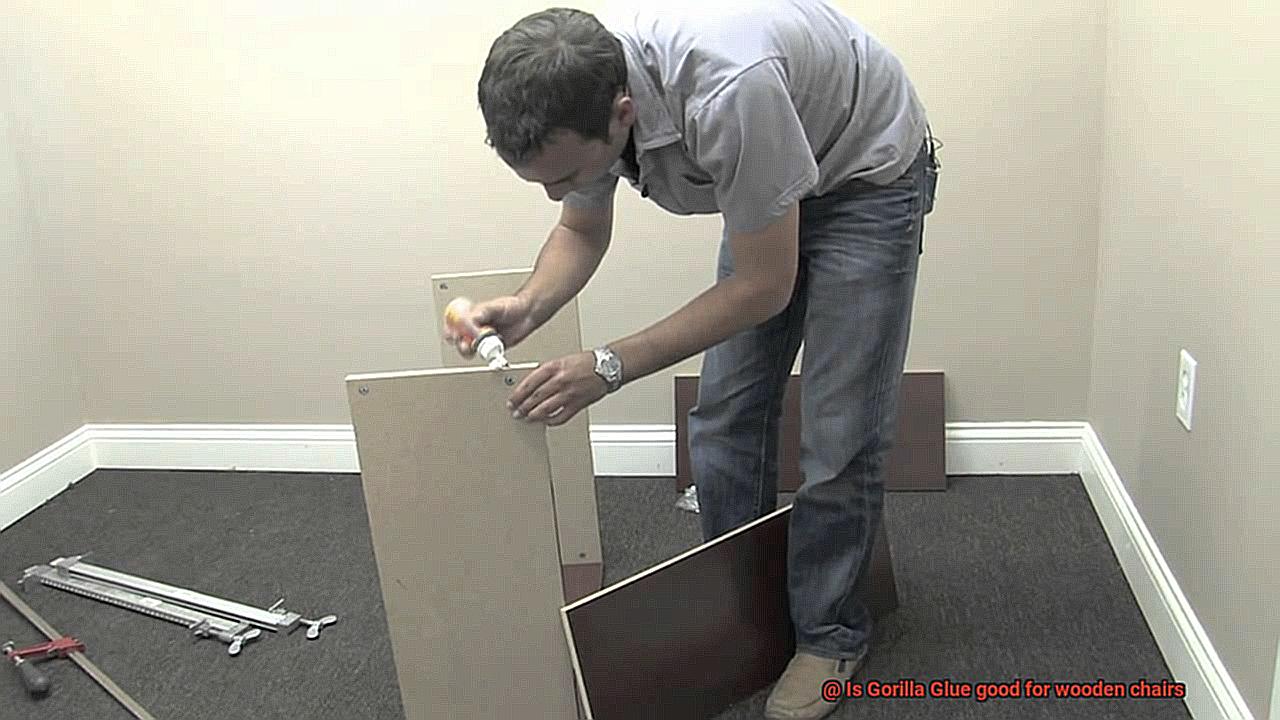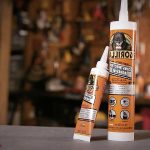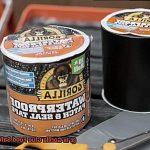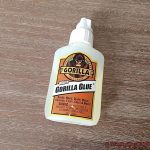When it comes to DIY projects and reviving tired wooden chairs, finding the right adhesive can be a real head-scratcher. That’s where Gorilla Glue swoops in like a superhero of stickiness, capturing the attention of DIY enthusiasts and pros alike.
But does this glue live up to all the hype? Today, we’re going to dig deep into the world of adhesives and explore whether Gorilla Glue is truly a match made in heaven for your wooden chairs. Get ready to uncover the truth, get inspired, and unleash your inner handyman as we embark on this sticky adventure.
What is Gorilla Glue?
Contents
- 1 What is Gorilla Glue?
- 2 Types of Wood Suitable for Gorilla Glue
- 3 Applying Gorilla Glue to Wooden Chairs
- 4 Intended Use of the Chair
- 5 Finishes and Staining with Gorilla Glue
- 6 Preparing the Surfaces for Adhesion
- 7 Pros and Cons of Using Gorilla Glue on Wooden Chairs
- 8 Alternatives to Gorilla Glue
- 9 Conclusion
When it comes to repairing or constructing wooden chairs, finding the right adhesive is crucial. Look no further than Gorilla Glue, a versatile and powerful adhesive known for its exceptional bonding strength. In this blog post, we will explore what makes Gorilla Glue unique and how you can use it effectively on your wooden chairs.
A Versatile Adhesive:
Gorilla Glue stands out as a polyurethane-based adhesive that bonds various surfaces with unmatched strength. From wood to metal, ceramic to stone, Gorilla Glue can create a strong and durable bond between different materials, making it the go-to adhesive for woodworking projects.
Expanding Nature:
One of Gorilla Glue’s standout features is its expanding nature. When applied, this remarkable adhesive expands to fill gaps and irregularities in the surfaces being bonded. This not only enhances the strength of the bond but also makes it ideal for joining or repairing wooden chairs with minor imperfections. Say goodbye to wobbly chairs.
Resistance to Water and Extreme Temperatures:
Gorilla Glue is designed to withstand exposure to moisture and extreme temperatures once cured. Whether your wooden chairs are placed outdoors or in humid indoor spaces, you can trust Gorilla Glue to provide durability and reliability. It ensures that your chairs remain strong and intact, even in challenging environmental conditions.
Application Tips:
To ensure optimal results when using Gorilla Glue on your wooden chairs, follow these simple steps:
- Prepare the surfaces: Thoroughly clean the surfaces, removing any dust or debris. Lightly sanding the areas can also improve bonding strength.
- Apply a thin layer: Use a brush or applicator to evenly apply a thin layer of Gorilla Glue on one surface.
- Press firmly: Join the surfaces together firmly, ensuring proper alignment. There is no need for excessive pressure; just enough to establish contact.
- Cure time: Follow the manufacturer’s instructions for the recommended curing time. This allows the glue to expand and bond the surfaces effectively.
Types of Wood Suitable for Gorilla Glue
Crafting or repairing wooden chairs requires the right adhesive, and Gorilla Glue is a popular choice known for its strength and versatility. However, not all types of wood are compatible with Gorilla Glue. In this article, we will explore the different woods that work well with Gorilla Glue and provide some useful tips to ensure a successful bonding experience.
Softwoods: Pine, Cedar, and Fir
Softwoods like pine, cedar, and fir are prized for their easy workability. These woods have a lower density that allows Gorilla Glue to penetrate their fibers deeply, creating an unyielding bond. When using Gorilla Glue on softwoods, you can expect exceptional strength and reliability.
Hardwoods: Oak, Maple, Cherry
Hardwoods such as oak, maple, and cherry are renowned for their durability and tight grain structure. Although Gorilla Glue may not penetrate hardwoods as easily due to their dense nature, it can still be effectively used. To enhance the bond, roughening the wood surface before applying Gorilla Glue will ensure a secure connection that stands the test of time.
Exotic Woods: Teak, Mahogany, Rosewood
Exotic woods like teak, mahogany, and rosewood possess a dense composition that can pose adhesion challenges due to natural oils or resins. Before applying Gorilla Glue to exotic woods, it is essential to clean the surface thoroughly to remove any potential obstacles. By doing so, you can achieve a strong bond that will endure even in the face of challenging conditions.
Plywood and Engineered Wood Products
Plywood is made from thin layers of wood glued together, and it is commonly used in chair construction. The good news is that Gorilla Glue is compatible with plywood as it adheres well to the glued layers, ensuring a secure and dependable bond. When working with plywood, ensure that the glue adheres to the wood veneer rather than the adhesive used in plywood construction for optimal results.
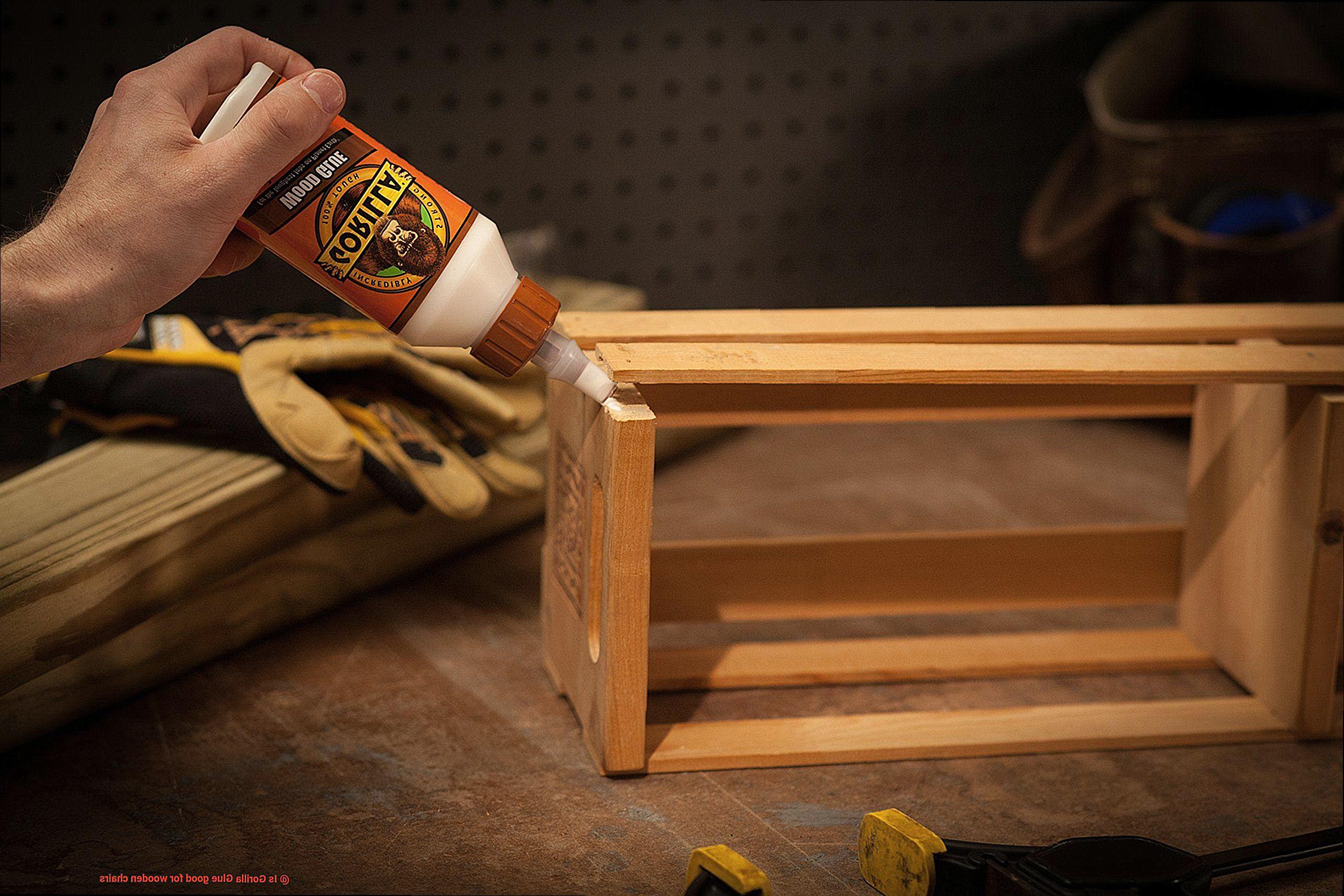
Veneer and Delicate Wood Surfaces
Gorilla Glue’s expanding property makes it unsuitable for use on veneer or delicate wood surfaces. The glue’s expansion potential can lead to warping or damage to these types of wood. If you are working with veneer or delicate wood, it is best to explore alternative adhesives that do not have expanding properties.
Testing and Preparing the Wood
Before using Gorilla Glue, always conduct a small test on a hidden area of the wood to determine its compatibility. Additionally, ensure that the wood surface is clean and free from debris. Consider sanding or roughening the surface to enhance adhesive properties and create a stronger bond.
Applying Gorilla Glue to Wooden Chairs
Whether they’re wobbly or have unsightly cracks, fear not. Gorilla Glue is here to save the day and bring those chairs back to life.
Before we delve into the process of applying Gorilla Glue to your wooden chairs, let’s go over a few essential points. First and foremost, cleanliness is key. You want to start with surfaces that are clean and free from any dirt or debris. Grab a mild detergent and warm water, give those chairs a thorough scrub, and make sure they’re completely dry before moving on.
Once your chairs are squeaky clean, it’s time to roughen up the surfaces that will be bonded. This may sound counterintuitive, but trust me, it’s crucial for a strong bond. Take some fine-grit sandpaper and gently sand the areas. Think of it as giving the glue something to grip onto, like when you climb a rock wall.
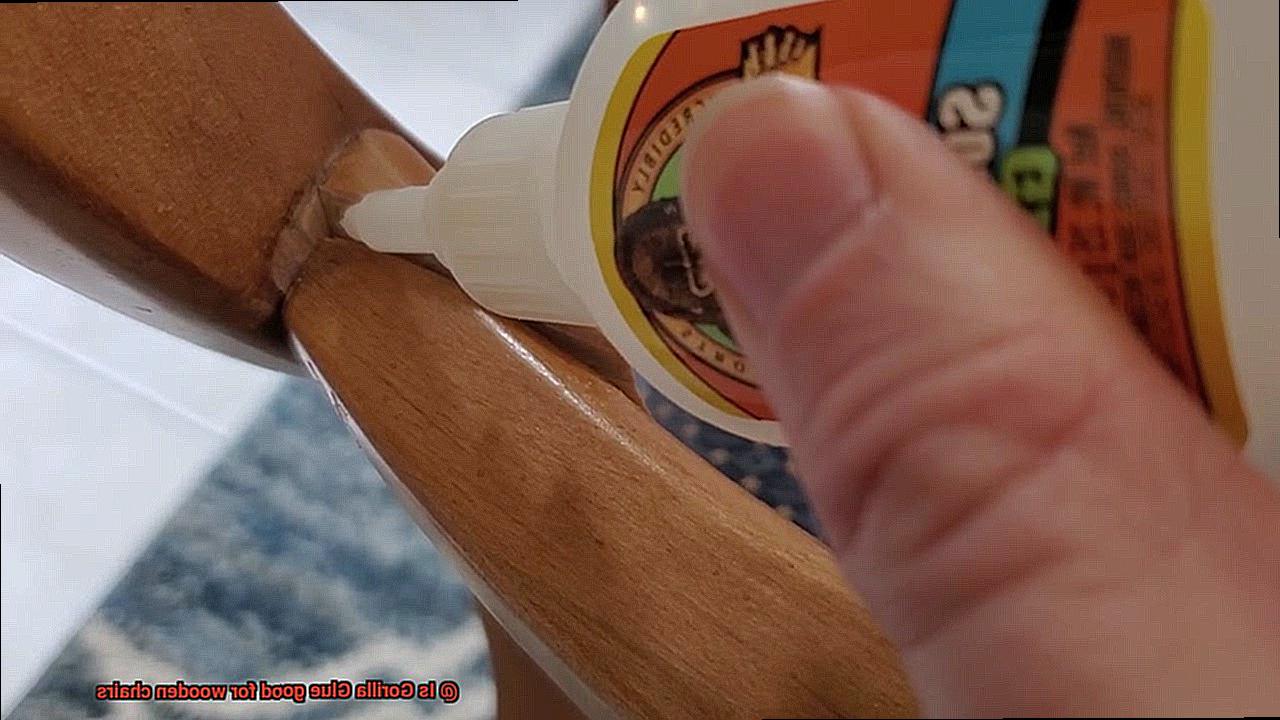
Now that your chairs are prepped and ready, it’s time for the star of the show – Gorilla Glue. But before you dive in headfirst, take a moment to read and follow the instructions provided by the manufacturer. Different types of Gorilla Glue may have specific guidelines for application and curing times, so it’s crucial to adhere to them for optimal results.
When it comes time to apply the glue, remember that less is more. A thin and even layer on both surfaces is all you need. Applying too much glue can lead to excess squeeze-out and a messy finish – nobody wants that. Apply just enough glue to cover the surface without going overboard.
Once the glue is applied, it’s time to bring out the heavy artillery – clamps or heavy objects. Applying pressure on the glued surfaces will ensure a secure bond and prevent any movement while the glue dries. We don’t want those chairs getting up and walking away, do we?
Now, here’s a little tip for you – Gorilla Glue expands as it cures. This expansion can lead to foaming and bubbling, which may not be ideal for certain chair surfaces. So, use the glue sparingly and avoid excessive application to prevent any unwanted foam or squeeze-out. We want those chairs looking beautiful, not like they just got slimed.
Once the glue has dried and cured completely, you’ll be left with a strong and durable bond between the wooden surfaces. Gorilla Glue provides excellent resistance to moisture, temperature changes, and general wear and tear, making it perfect for those chairs that see a lot of action.
Intended Use of the Chair
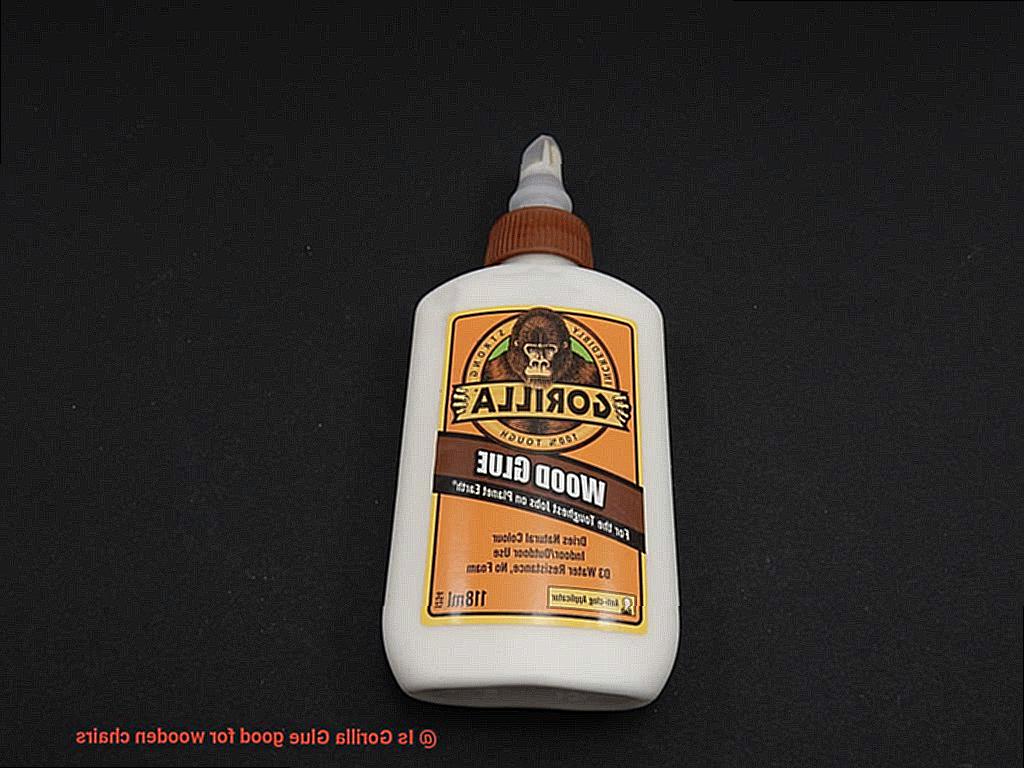
Wooden chairs are more than just functional pieces of furniture; they add charm and warmth to any space. Whether you’re fixing a wobbly leg or breathing new life into an old chair, choosing the right glue is essential. In this comprehensive guide, we’ll explore the considerations for using Gorilla Glue on wooden chairs based on their intended use. So, sit back, relax, and let’s dive into the fascinating world of chair restoration.
Indoor Chairs:
Indoor chairs, found in homes or offices, typically face minimal exposure to moisture and temperature variations. When it comes to these chairs, Gorilla Glue emerges as a superhero choice. Its strong bonding properties provide a durable bond that can withstand regular use and weight-bearing without compromising stability. Just remember to apply the glue evenly to avoid unsightly drips that could detract from the chair’s beauty.
Outdoor Chairs:
Outdoor chairs, such as patio or garden chairs, brave the elements daily. While Gorilla Glue is water-resistant, constant exposure to rain or humidity can slowly degrade its bond over time. For outdoor wooden chairs, it’s best to consider weatherproof wood glues or epoxy adhesives specifically designed to withstand moisture and temperature fluctuations. These specialized adhesives will ensure your chairs remain sturdy and reliable, even in the face of Mother Nature’s fury.
High-Use Chairs:
Chairs that experience heavy usage, like dining chairs in bustling households or public spaces, require a glue that can handle the pressure. Enter Gorilla Glue with its superhero strength and durability. It’s an ideal choice for these high-use wooden chairs. However, for extra reinforcement and peace of mind, consider using screws or dowels in conjunction with the glue. This added support will ensure your chairs remain steadfast through countless gatherings and busy moments.
Decorative Chairs:
Decorative chairs serve primarily aesthetic purposes and may not experience regular use or weight-bearing. For these chairs, Gorilla Glue can be a suitable partner. Its reliable bond will keep your decorative chairs intact, preserving their beauty for years to come. However, before applying the glue, it’s crucial to test a small area first to ensure compatibility with the wood type and any surface finishes or coatings. This precautionary step will protect your chairs from any potential damage caused by incompatible adhesives.
Finishes and Staining with Gorilla Glue
In this comprehensive guide, we will explore the considerations you need to keep in mind when using Gorilla Glue in conjunction with finishes and stains on your beloved wooden chairs. Get ready to unleash the magic of Gorilla Glue and create chairs that will stand the test of time.
Chapter 1: The Power of Gorilla Glue
Gorilla Glue comes in different types, including original, clear, and wood glue, each with its own unique set of superpowers. Whether it’s providing a strong bond or ensuring durability, Gorilla Glue is a reliable adhesive that will bring your wooden chairs back to life.
Chapter 2: Applying Gorilla Glue Like a Pro
Proper application techniques are crucial when using Gorilla Glue on wooden chairs. From applying the right amount of glue to allowing it to cure fully, we will guide you through the steps to ensure optimal results.
Chapter 3: Choosing the Perfect Finish or Stain
Choosing the right finish or stain can make all the difference in enhancing the beauty and longevity of your wooden chairs. We will explore various types of finishes and stains suitable for wooden chairs, discussing compatibility issues between Gorilla Glue and certain products. With our tips, you can confidently select a finish or stain that complements your chair’s design.
Chapter 4: Mastering the Art of Staining
Staining wooden chairs can be a rewarding process, but it requires precision. We will provide you with step-by-step instructions for staining wooden chairs with Gorilla Glue. Additionally, we will highlight the importance of masking off areas with glue to prevent uneven or discolored staining.
Chapter 5: Troubleshooting and Expert Tips
Even with the best intentions, challenges may arise when working with Gorilla Glue and finishes/stains. We will address common issues and provide expert tips for achieving flawless results. With our guidance, you can overcome any obstacles and maintain the longevity of your beautifully restored chairs.
Preparing the Surfaces for Adhesion
Well, hold on tight because we’re about to reveal a secret that many people overlook – the importance of properly preparing surfaces before diving into your gluing adventure.
Think about it this way: you wouldn’t build a house without a solid foundation, right? Well, the same principle applies to gluing wooden chairs. Taking the time to prep your surfaces can make all the difference in the strength and durability of your bond. So, let’s dive into the nitty-gritty details.
First things first, cleanliness is key. You want your surfaces to be squeaky clean and free from any dirt or grease that could sabotage your glue job. Grab a damp cloth and wipe away any contaminants. If you’re dealing with stubborn grime, a mild detergent can work wonders. Just make sure everything is bone dry before moving on to the next step.
Now that your surfaces are spotless, it’s time to roughen things up a bit. No, not emotionally – we’re talking about sanding. Use fine-grit sandpaper or a wire brush to create tiny grooves and scratches on the wood. This gives your Gorilla Glue something to grip onto for a stronger bond. Plus, it helps remove any existing finishes or coatings that might interfere with the adhesion process.
But wait, there’s more. Consider applying a primer or conditioner specifically designed for wood. These magical potions seal and condition the wood, ensuring better adhesion and reducing the risk of moisture absorption. Follow the instructions provided by the manufacturer to apply them correctly – they know their stuff.
Speaking of moisture, wood is a living thing that loves to expand and contract with changes in humidity levels. Before you go gluing away, use a wood moisture meter to make sure your wooden pieces are within the acceptable range. If they’re too wet or too dry, hold your horses and wait until they stabilize before proceeding. Trust us, patience is a virtue in this case.
Last but not least, let’s talk about clamping – no, not your uncle’s weird hobbies. When using Gorilla Glue, it’s essential to apply pressure to the bond by clamping the surfaces together. This helps squeeze out excess glue and ensures maximum contact between the adhesive and the wood. Grab some clamps or get creative with other suitable methods to hold everything in place while the glue works its magic.
And voila. By following these simple steps, you’ll become a surface-prepping guru and create wooden chairs that can withstand the test of time. Just imagine sitting on your sturdy, reliable masterpiece, knowing that you took the extra time to prepare those surfaces for adhesion. Bravo, my friend – you’ve earned it.
Pros and Cons of Using Gorilla Glue on Wooden Chairs
When it comes to repairing or assembling wooden chairs, choosing the right adhesive is crucial. Gorilla Glue is a popular choice among DIY enthusiasts and professionals alike. In this article, we will explore the pros and cons of using Gorilla Glue on wooden chairs to help you make an informed decision.
Pros of Using Gorilla Glue on Wooden Chairs:
- Strong Bond: One of the biggest advantages of Gorilla Glue is its exceptional bonding strength. It creates a strong and durable bond between wood pieces, ensuring that your wooden chairs remain sturdy and stable for a long time.
- Water Resistance: Wooden chairs are often exposed to moisture or humidity, which can weaken traditional wood glues. Gorilla Glue, however, is water-resistant, making it ideal for chairs used outdoors or in areas prone to spills or dampness. It maintains its strength even when exposed to moisture, ensuring the longevity of your wooden chairs.
- Versatility: Gorilla Glue is a versatile adhesive that can bond different types of wood, including hardwoods and softwoods. It can also adhere to other materials commonly found in chairs, such as plastic or metal. This versatility allows for flexibility in repairing or assembling various types of wooden chairs.
Cons of Using Gorilla Glue on Wooden Chairs:
- Expanding Nature: One drawback of Gorilla Glue is its expanding nature when it cures. While this feature helps fill gaps and spaces, it can create challenges when working with delicate or precise wooden joinery. Excess glue may squeeze out and leave messy residue that requires additional cleaning and sanding.
- Long Curing Time: Compared to other wood glues, Gorilla Glue has a relatively long curing time. While traditional glues may dry within hours, Gorilla Glue typically requires 24 hours or more to fully cure. This extended drying period can be inconvenient, especially if you need to use or move the chair during the process.
- Difficult to Remove: Once fully cured, Gorilla Glue becomes incredibly strong and difficult to remove. While this is advantageous for the chair’s longevity, it can be problematic if you ever need to disassemble or repair the chair in the future. Removing Gorilla Glue requires labor-intensive efforts and may cause damage to the wood surface.
Alternatives to Gorilla Glue
When it comes to repairing your beloved wooden chairs, finding the perfect adhesive is key. While Gorilla Glue may be the go-to choice for many, there are alternatives out there that might just suit your needs even better. So, grab a seat and let’s dive into some fantastic alternatives to Gorilla Glue.
First up, we have wood glue. Also known as carpenter’s glue or PVA glue, this gem is specifically designed for bonding wood surfaces. It offers a strong and durable bond that’s perfect for joining broken legs or fixing loose joints. Plus, it dries faster than Gorilla Glue, saving you precious time on your chair repairs.
Next on our list is epoxy resin. This two-part adhesive is a powerhouse when it comes to durability and resistance. It’s excellent for repairing chairs exposed to outdoor elements or high humidity environments. With its water-resistant properties and ability to withstand heavy loads, your chairs will be ready to handle anything life throws at them.
If you’re dealing with small cracks or delicate wooden chairs, super glue (cyanoacrylate glue) might be your best bet. It bonds quickly and securely, making it ideal for those tiny repairs. Just keep in mind that it may not be as strong as other alternatives for larger fixes.
Now, if you’re all about going natural, hide glue is a fantastic option. Made from collagen extracted from animal hides, this ancient adhesive has been trusted by woodworkers for centuries. It offers superior adhesion to wood and can be easily reversed using heat and moisture, making it perfect for furniture restoration projects.
Last but certainly not least, we have polyurethane glue (PU glue). This bad boy expands as it cures, creating a solid bond between wooden surfaces. It’s fantastic for fixing loose joints or filling gaps in your chairs. Plus, it can handle water, heat, and chemicals like a champ, making it suitable for both indoor and outdoor repairs.
9NjEvsgNvew” >
Also Read: Does Gorilla Glue Work On Fabric?
Conclusion
In conclusion, Gorilla Glue is indeed a reliable adhesive for wooden chairs.
Its strong and durable formula ensures that the bond between the wood pieces remains intact for a long time. Whether you’re repairing a broken chair leg or securing loose joints, Gorilla Glue provides a solid solution.
So, if you want to extend the lifespan of your beloved chairs and maintain their structural integrity, Gorilla Glue is definitely worth considering.

